Kinematic Analysis of Dynamic Coactivation During Arm Swing at the Shoulder and Elbow Joints
Abstract
1. Introduction
2. Materials and Methods
2.1. Subject
2.2. Apparatus
2.3. Experimental Design
2.4. Procedure
2.5. Analysis
3. Results
3.1. Shoulder (Flexion–Extension)
3.2. Shoulder (Abduction–Adduction)
3.3. Elbow (Flexion–Extension)
4. Discussion
5. Conclusions
- Arm swing is essential for maintaining walking stability and minimizing energy expenditure, especially as walking speed increases.
- Shoulder range of motion (ROM) was slightly lower at the preferred walking speed (PWS) compared to the slowest walking speed (3.6 km/h). The PWS facilitates more natural limb movement, thereby improving walking stability.
- Dynamic covariation of torque patterns in the shoulder and elbow joints was observed, reflecting a synergistic coordination between these joints in response to human body movement.
Author Contributions
Funding
Institutional Review Board Statement
Informed Consent Statement
Data Availability Statement
Conflicts of Interest
References
- Asbeck, A.T.; De Rossi, S.M.M.; Galiana, I.; Ding, Y.; Walsh, C.J. Stronger, smarter, softer: Next-generation wearable robots. IEEE Robot. Autom. Mag. 2014, 21, 22–33. [Google Scholar] [CrossRef]
- Low, K.H.; Liu, X.; Goh, C.H.; Yu, H. Locomotive control of a wearable lower exoskeleton for walking enhancement. J. Vib. Control 2006, 12, 1311–1336. [Google Scholar] [CrossRef]
- Esquenazi, A.; Talaty, M.; Packel, A.; Saulino, M. The ReWalk powered exoskeleton to restore ambulatory function to individuals with thoracic-level motor-complete spinal cord injury. Am. J. Phys. Med. Rehabil. 2012, 91, 911–921. [Google Scholar] [CrossRef] [PubMed]
- Lee, H.; Ho, P.; Rastgaar, M.; Krebs, H.I.; Hogan, N. Multivariable static ankle mechanical impedance with active muscles. IEEE Trans. Neural Syst. Rehabil. Eng. 2014, 22, 44–52. [Google Scholar] [CrossRef]
- Herr, H. Exoskeletons and orthoses: Classification, design challenges and future directions. J. Neuroeng. Rehabil. 2009, 6, 1–9. [Google Scholar] [CrossRef]
- Grillner, S. Control of Locomotion in Bipeds, Tetrapods, and Fish; John Wiley & Sons, Inc.: Hoboken, NJ, USA, 2011. [Google Scholar]
- Hassan, M.; Kadone, H.; Ueno, T.; Hada, Y.; Sankai, Y.; Suzuki, K. Feasibility of synergy-based exoskeleton robot control in hemiplegia. IEEE Trans. Neural Syst. Rehabil. Eng. 2018, 26, 1233–1242. [Google Scholar] [CrossRef]
- Browning, R.C.; Modica, J.R.; Kram, R.; Goswami, A. The effects of adding mass to the legs on the energetics and biomechanics of walking. Med. Sci. Sports Exerc. 2007, 39, 515–525. [Google Scholar] [CrossRef]
- Moschetti, A.; Cavallo, F.; Esposito, D.; Penders, J.; Di Nuovo, A. Wearable sensors for human–robot walking together. Robotics 2019, 8, 38. [Google Scholar] [CrossRef]
- St-Onge, N.; Feldman, A.G. Interjoint coordination in lower limbs during different movements in humans. Exp. Brain Res. 2003, 148, 139–149. [Google Scholar] [CrossRef]
- Jacobson, M.; Kantharaju, P.; Jeong, H.; Ryu, J.K.; Park, J.J.; Chung, H.J.; Kim, M. Foot contact forces can be used to personalize a wearable robot during human walking. Sci. Rep. 2022, 12, 10947. [Google Scholar] [CrossRef]
- Meyns, P.; Bruijn, S.M.; Duysens, J. The how and why of arm swing during human walking. Gait Posture 2013, 38, 555–562. [Google Scholar] [CrossRef] [PubMed]
- Kuhtz-Buschbeck, J.P.; Jing, B. Activity of upper limb muscles during human walking. J. Electromyogr. Kinesiol. 2012, 22, 199–206. [Google Scholar] [CrossRef] [PubMed]
- Goudriaan, M.; Jonkers, I.; van Dieen, J.H.; Bruijn, S.M. Arm swing in human walking: What is their drive? Gait Posture 2014, 40, 321–326. [Google Scholar] [CrossRef] [PubMed]
- Eke-Okoro, S.T.; Gregoric, M.; Larsson, L.E. Alterations in gait resulting from deliberate changes of arm-swing amplitude and phase. Clin. Biomech. 1997, 12, 516–521. [Google Scholar] [CrossRef]
- Meyns, P.; Van Gestel, L.; Bruijn, S.M.; Desloovere, K.; Swinnen, S.; Duysens, J. Is interlimb coordination during walking preserved in children with cerebral palsy? Gait Posture 2012, 36, S25. [Google Scholar] [CrossRef]
- Meyns, P.; Van Gestel, L.; Massaad, F.; Desloovere, K.; Molenaers, G.; Duysens, J. Arm swing during walking at different speeds in children with Cerebral Palsy and typically developing children. Res. Dev. Disabil. 2011, 32, 1957–1964. [Google Scholar] [CrossRef]
- Romakes, J.; Bracht-Schweizer, K. The effects of walking speed on upper body kinematics during gait in healthy subjects. Gait Posture 2017, 54, 304–310. [Google Scholar] [CrossRef]
- Wagenaar, R.C.; van Emmerik, R.E. Resonant frequencies of arms and legs identify different walking patterns. J. Biomech. 2000, 33, 853–861. [Google Scholar] [CrossRef]
- Kim, J.H.; Hwang, J.; Jung, M.C.; Mo, S.M. The kinematic evaluation of shoulder and elbow joints for different walking speeds. Int. J. Eng. Technol. 2019, 11, 169–172. [Google Scholar] [CrossRef]
- Klaner, T.; Pearcey, G.E.P.; Sun, Y.; Brass, T.S.; Zehr, E.P. Changing coupling between the arms and legs with slow walking speeds alters regulation of somatosensory feedback. Exp. Brain Res. 2020, 238, 1335–1349. [Google Scholar] [CrossRef]
- Faul, F.; Erdfelder, E.; Lang, A.-G.; Buchner, A. G*Power 3: A flexible statistical power analysis program for the social, behavioral, and biomedical sciences. Behav. Res. Methods 2007, 39, 175–191. [Google Scholar] [CrossRef] [PubMed]
- Faul, F.; Erdfelder, E.; Buchner, A.; Lang, A.-G. Statistical power analyses using G*Power 3.1: Tests for correlation and regression analyses. Behav. Res. Methods 2009, 41, 1149–1160. [Google Scholar] [CrossRef] [PubMed]
- Upper Body Modeling with Plug-in Gait. Vicon Motion Systems Ltd. UK. Available online: https://help.vicon.com/space/Nexus216/11602259/Upper+body+modeling+with+Plug-in+Gait (accessed on 4 June 2025).
- Johnson, R.T.; Hafer, J.F.; Wedge, R.D.; Boyer, K.A. Comparison of measurement protocols to estimate preferred walking speed between sites. Gait Posture 2020, 77, 171–174. [Google Scholar] [CrossRef] [PubMed]
- Lythgo, N.; Wilson, C.; Galea, M. Basic gait and symmetry measures for primary school-aged children and young adults. II: Walking at slow, free and fast speed. Gait Posture 2011, 33, 29–35. [Google Scholar] [CrossRef]
- Shemmell, J.; Johansson, J.; Portra, V.; Gottlieb, G.L.; Thomas, J.S.; Corcos, D.M. Control of interjoint coordination during the swing phase of normal gait at different speeds. J. Neuroeng. Rehabil. 2007, 4, 1–14. [Google Scholar] [CrossRef]
- Bruijn, S.M.; Meijer, E.G.; Beek, P.J.; van Dieën, J.H. The effects of arm swing on human gait stability. J. Exp. Biol. 2010, 213, 3945–3952. [Google Scholar] [CrossRef]
- Meyns, P.; Van de Walle, P.; Hoogkamer, W.; Kiekens, C.; Desloovere, K.; Duysens, J. Coordinating arms and legs on a hybrid rehabilitation tricycle: The metabolic benefit of asymmetrical compared to symmetrical arm movements. Eur. J. Appl. Physiol. 2014, 114, 743–750. [Google Scholar] [CrossRef]
- Ortega, J.D.; Fehlman, L.A.; Farley, C.T. Effects of aging and arm swing on the metabolic cost of stability in human walking. J. Biomech. 2008, 41, 3303–3308. [Google Scholar] [CrossRef]
- Umberger, B.R. Effects of suppressing arm swing on kinematics, kinetics, and energetics of human walking. J. Biomech. 2008, 41, 2575–2580. [Google Scholar] [CrossRef]
- Kubo, M.; Wagenaar, R.C.; Saltzman, E.; Holt, K.G. Biomechanical mechanism for transitions in phase and frequency of arm and leg swing during walking. Biol. Cybern. 2004, 91, 91–98. [Google Scholar] [CrossRef][Green Version]
- Punt, M.; Bruijn, S.M.; Wittink, H.; van Dieën, J.H. Effect of arm swing strategy on local dynamic stability of human gait. Gait Posture 2015, 41, 504–509. [Google Scholar] [CrossRef] [PubMed]
- Cavagna, G.A.; Kaneko, M. Mechanical work and efficiency in level walking and running. J. Physiol. 1977, 268, 467–481. [Google Scholar] [CrossRef] [PubMed]
- Pontzer, H.; Holloway, J.H., 4th; Raichlen, D.A.; Lieberman, D.E. Control and function of arm swing in human walking and running. J. Exp. Biol. 2009, 212, 523–534. [Google Scholar] [CrossRef] [PubMed]
- Schöner, G.; Jiang, W.Y.; Kelso, J.A.S. A synergetic theory of quadrupedal gaits and gait transitions. J. Theor. Biol. 1990, 142, 359–391. [Google Scholar] [CrossRef]
- Jeka, J.J.; Kelso, J.A.S.; Kiemel, T. Pattern switching in human multilimb coordination dynamics. Bull. Math. Biol. 1993, 55, 829–845. [Google Scholar] [CrossRef]
- Delabastita, T.; Desloovere, K.; Meyns, P. Restricted arm swing affects gait stability and increased walking speed alters trunk movements in children with cerebral palsy. Front. Hum. Neurosci. 2016, 15, 1–16. [Google Scholar] [CrossRef]
- Tester, N.J.; Howland, D.R.; Day, K.V.; Suter, S.P.; Cantrell, A.; Behrman, A.L. Device use, locomotor training and the presence of arm swing during treadmill walking after spinal cord injury. Spinal Cord. 2011, 49, 451–456. [Google Scholar] [CrossRef][Green Version]
- Galloway, J.; Koshland, G. General coordination of shoulder, elbow and wrist dynamics during multijoint arm movements. Exp. Brain Res. 2002, 142, 163–180. [Google Scholar] [CrossRef]
- Gribble, P.L.; Ostry, D.J. Independent coactivation of shoulder and elbow muscles. Exp. Brain Res. 1998, 123, 355–360. [Google Scholar] [CrossRef]
- Gottlieb, G.L.; Song, Q.; Hong, D.A.; Almeida, G.L.; Corcos, D. Coordinating movement at two joints: A principle of linear covariance. J. Neurophysiol. 1996, 75, 1760–1764. [Google Scholar] [CrossRef]
- Zaal, F.T.; Daigle, K.; Gottlieb, G.L.; Thelen, E. An unlearned principle for controlling natural movements. J. Neurophysiol. 1999, 82, 255–259. [Google Scholar] [CrossRef]

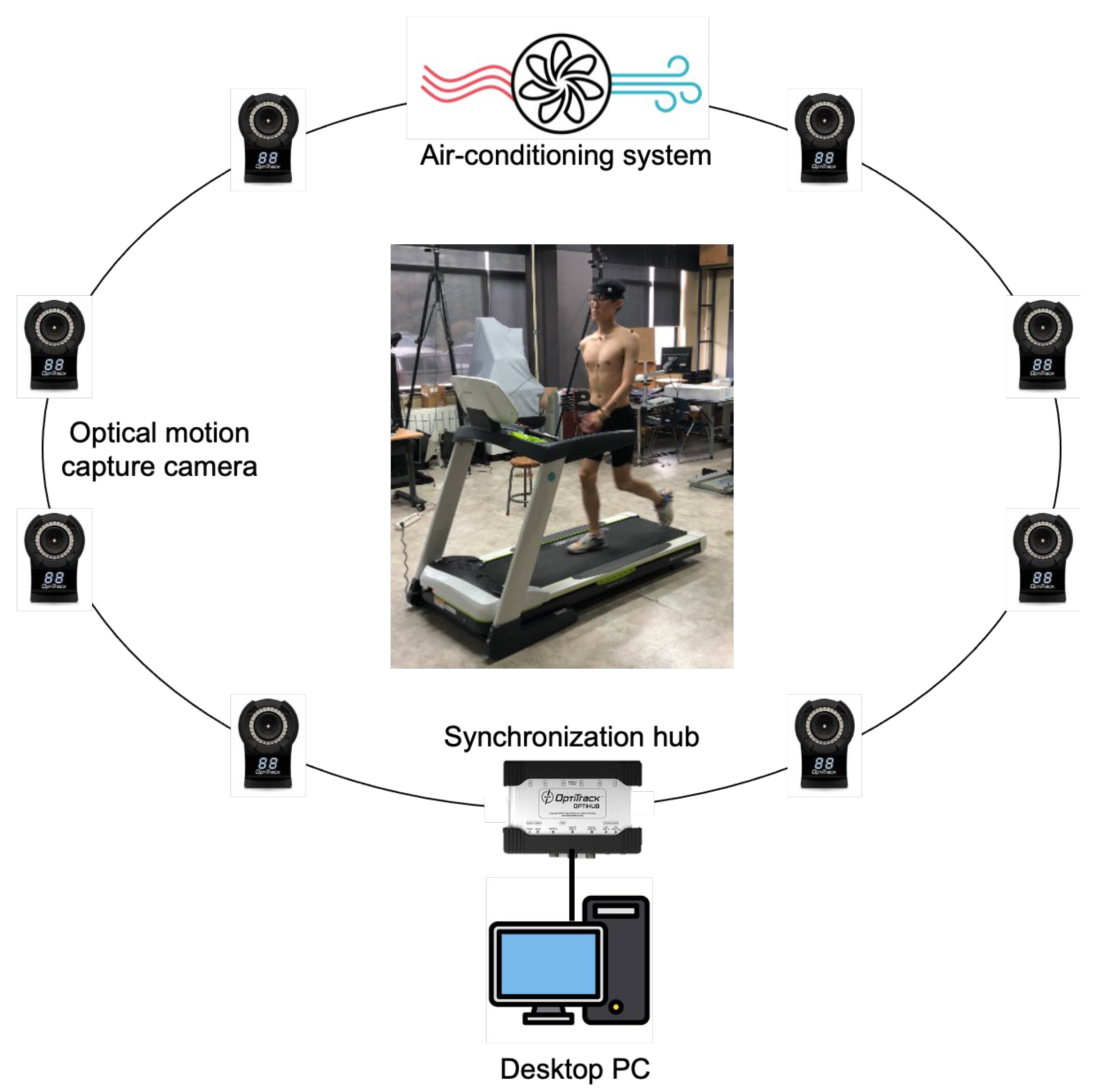
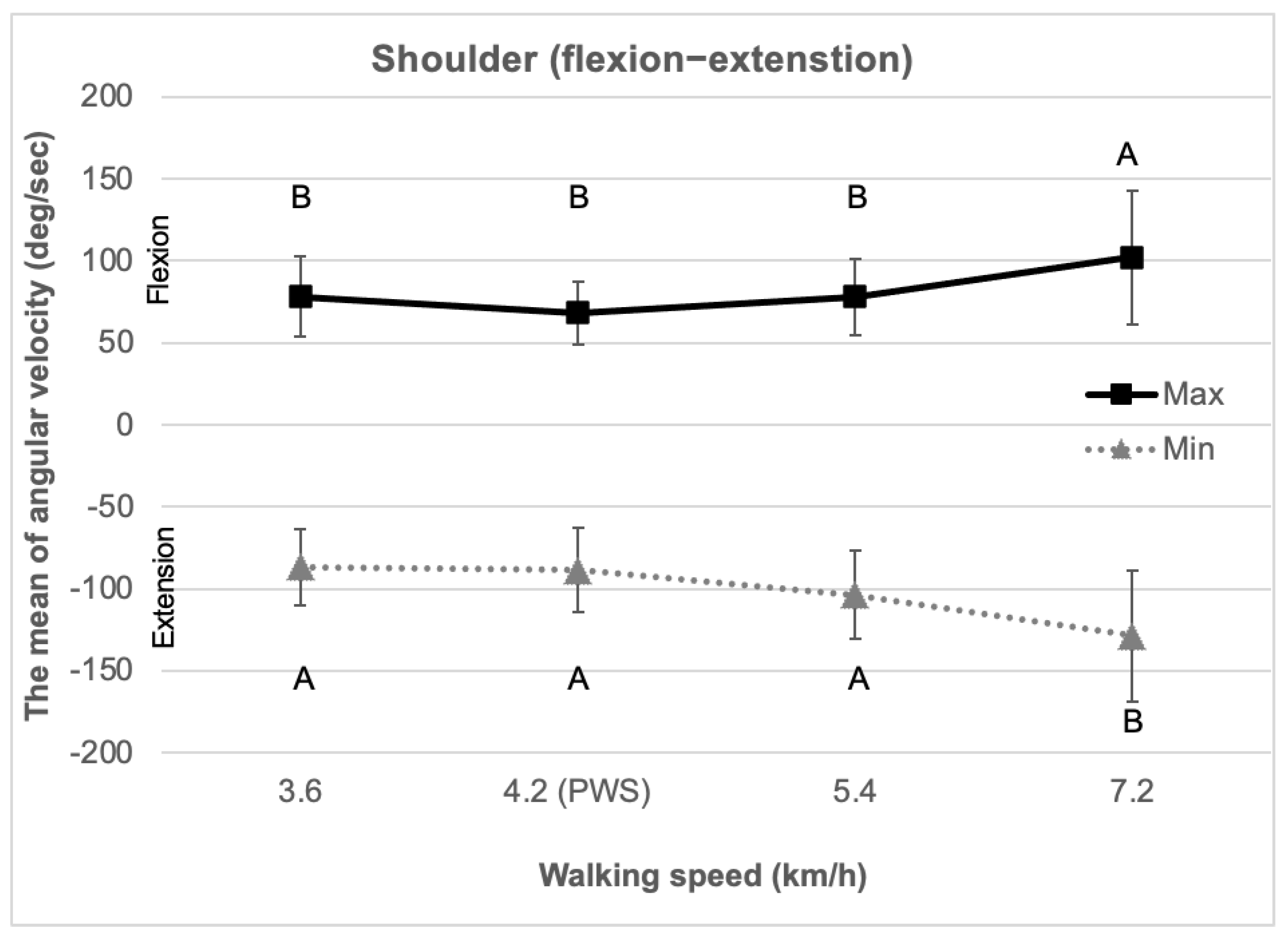
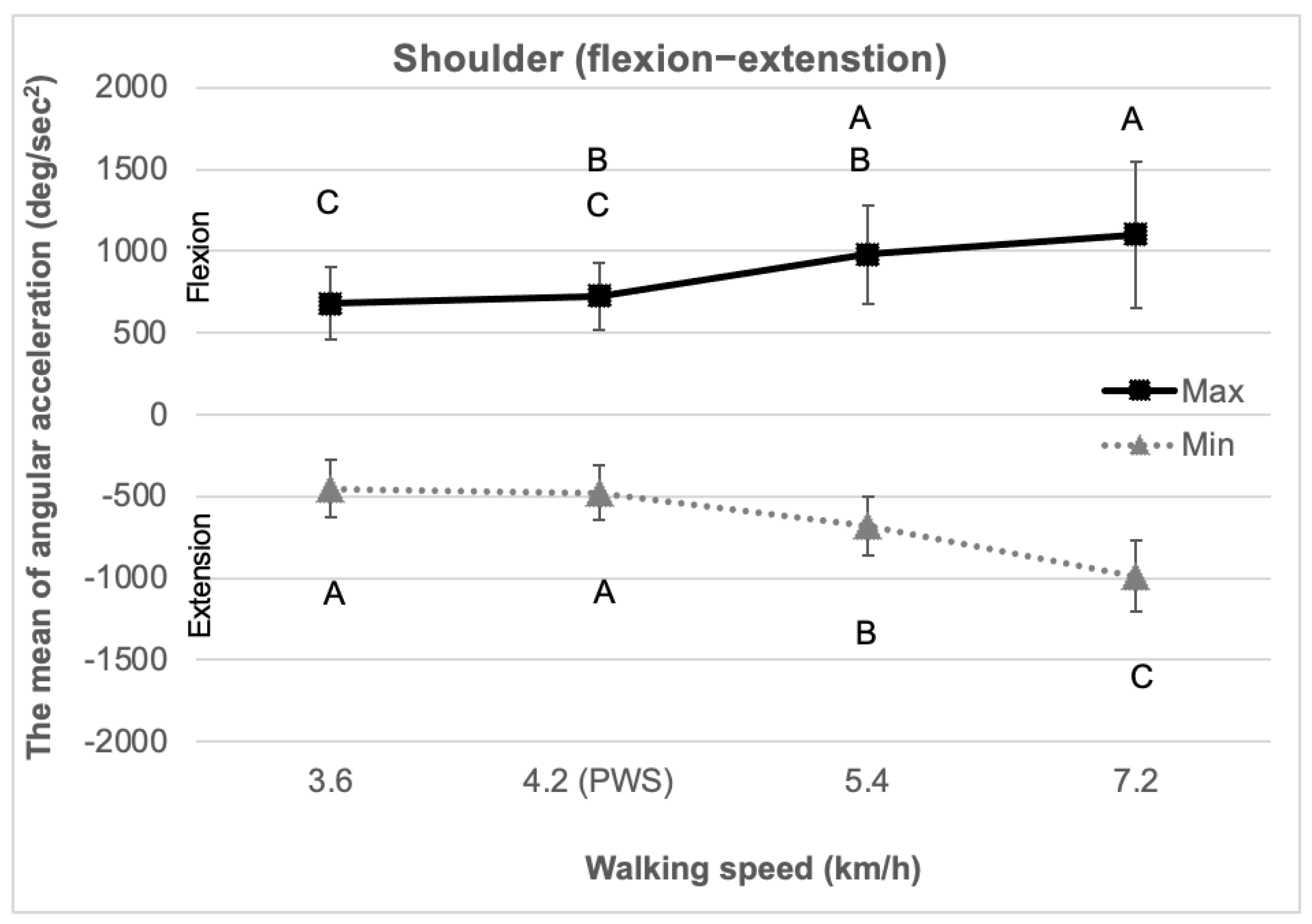
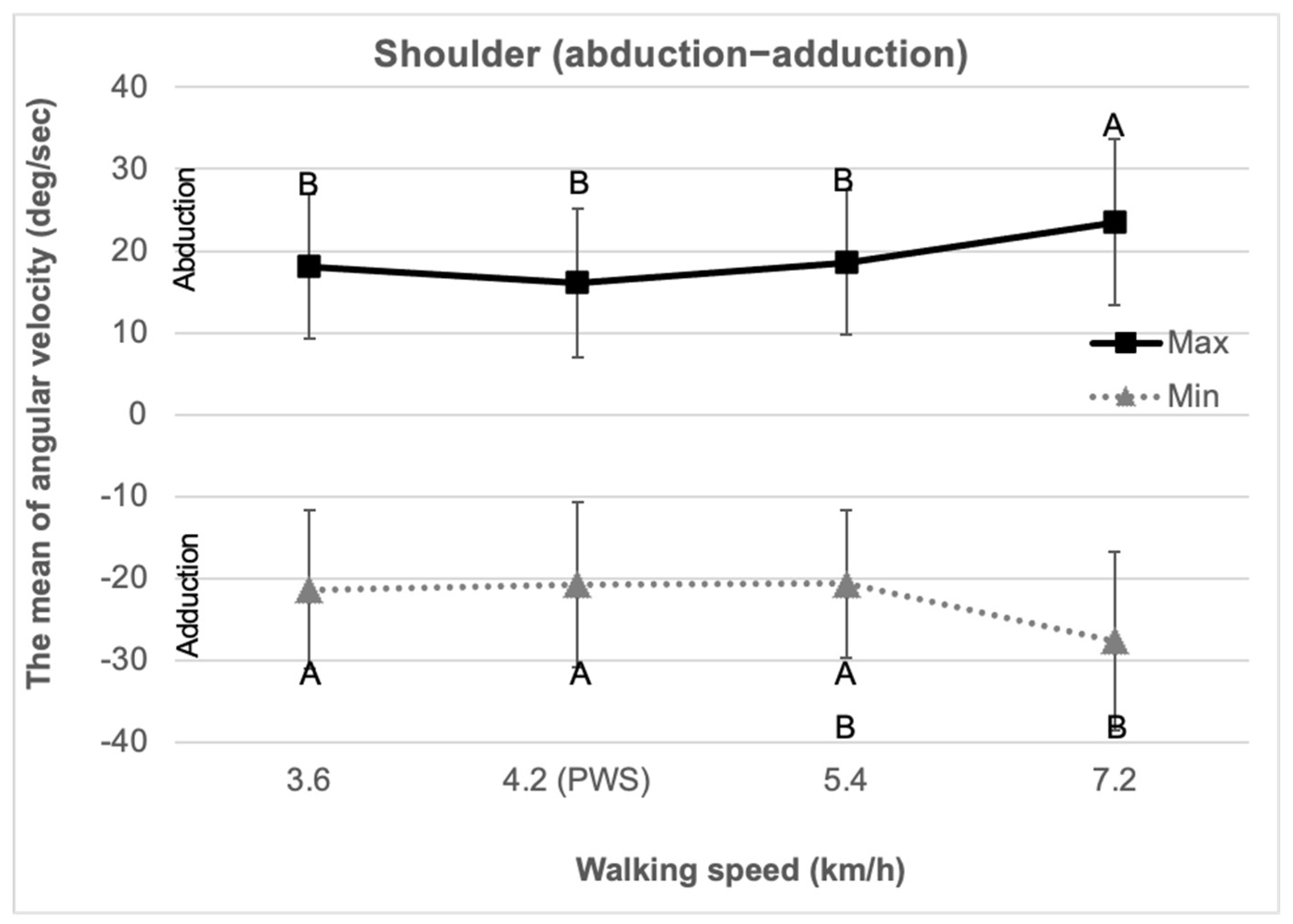
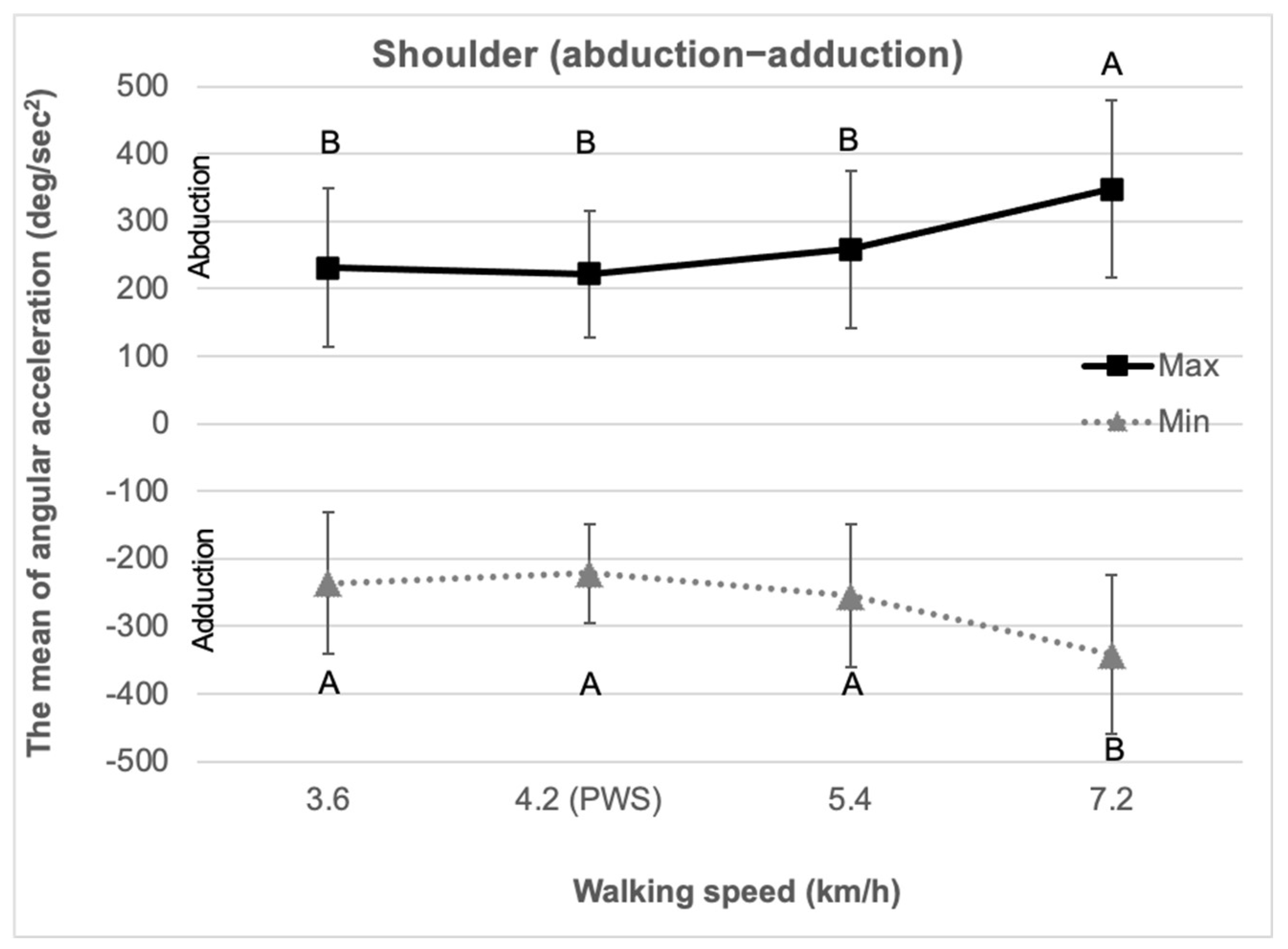

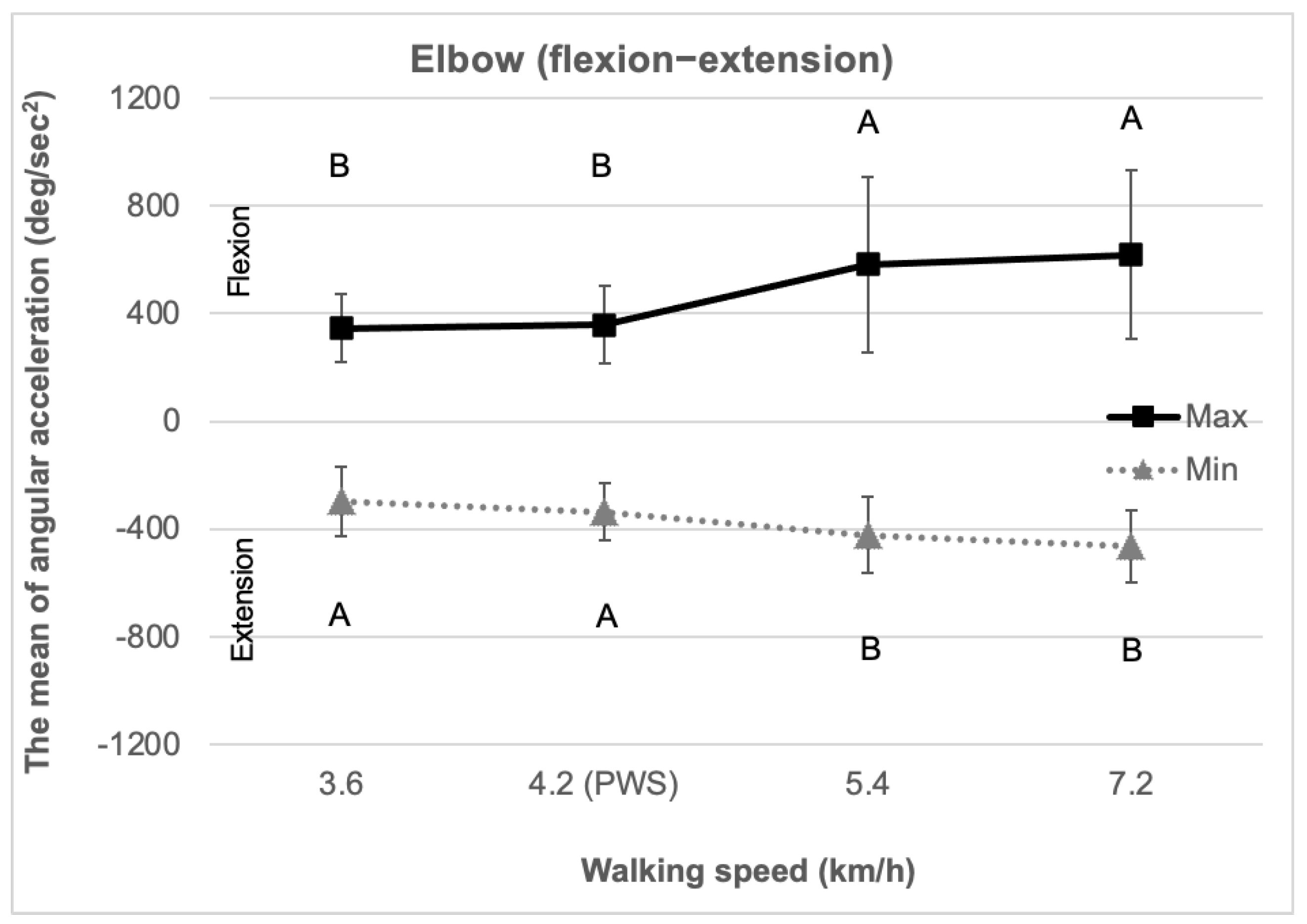
| Joint (Motion) | Kinematic Variable (Unit) | Walking Speed (km/h) | |||
|---|---|---|---|---|---|
| 3.6 | 4.2 (PWS) | 5.4 | 7.2 | ||
| Shoulder (flexion– extension) | Range of motion * (deg) | 27.1 (8.8) | 24.9 (8.4) | 28.4 (8.5) | 30.0 (9.9) |
| Maximum joint angular velocity ** (deg/s) | 78.2 (24.4) | 68.2 (19.4) | 77.9 (22.9) | 102.2 (40.8) | |
| Minimum joint angular velocity * (deg/s) | −86.9 (23.0) | −88.7 (25.5) | −104.0 (26.9) | −128.9 (40.3) | |
| Maximum joint angular acceleration * (deg/s2) | 680.2 (221.2) | 723.4 (203.4) | 979.8 (298.7) | 1102.8 (447.1) | |
| Minimum joint angular acceleration * (deg/s2) | −453.9 (174.3) | −478.1 (167.6) | −681.7 (181.2) | −987.9 (217.2) | |
| Shoulder (abduction–adduction) | Range of motion (deg) | 6.9 (2.7) | 6.6 (3.1) | 6.7 (4.2) | 6.4 (2.3) |
| Maximum joint angular velocity ** (deg/s) | 18.1 (8.8) | 16.1 (9.0) | 18.6 (8.9) | 23.5 (10.1) | |
| Minimum joint angular velocity ** (deg/s) | −21.4 (9.7) | −20.8 (10.0) | −20.7 (9.0) | −27.7 (10.9) | |
| Maximum joint angular acceleration ** (deg/s2) | 231.0 (117.2) | 221.9 (94.0) | 258.8 (117.0) | 347.6 (131.8) | |
| Minimum joint angular acceleration ** (deg/s2) | −236.5 (104.8) | −221.9 (73.7) | −254.8 (106.5) | −342.0 (117.4) | |
| Elbow (flexion– extension) | Range of motion * (deg) | 13.8 (5.1) | 14.3 (6.7) | 15.9 (6.9) | 17.3 (7.8) |
| Maximum joint angular velocity ** (deg/s) | 32.5 (13.4) | 38.1 (14.1) | 53.8 (22.9) | 58.4 (30.7) | |
| Minimum joint angular velocity ** (deg/s) | −29.0 (10.5) | −33.2 (13.6) | −48.9 (14.6) | −59.0 (22.8) | |
| Maximum joint angular acceleration ** (deg/s2) | 345.8 (128.4) | 358.2 (143.5) | 581.1 (325.4) | 618.2 (312.9) | |
| Minimum joint angular acceleration ** (deg/s2) | −297.8 (130.1) | −336.5 (106.8) | −423.5 (142.1) | −462.9 (134.4) | |
Disclaimer/Publisher’s Note: The statements, opinions and data contained in all publications are solely those of the individual author(s) and contributor(s) and not of MDPI and/or the editor(s). MDPI and/or the editor(s) disclaim responsibility for any injury to people or property resulting from any ideas, methods, instructions or products referred to in the content. |
© 2025 by the authors. Licensee MDPI, Basel, Switzerland. This article is an open access article distributed under the terms and conditions of the Creative Commons Attribution (CC BY) license (https://creativecommons.org/licenses/by/4.0/).
Share and Cite
Kim, J.H.; Hwang, J.; Jung, M.-C.; Mo, S.-M. Kinematic Analysis of Dynamic Coactivation During Arm Swing at the Shoulder and Elbow Joints. Appl. Sci. 2025, 15, 6593. https://doi.org/10.3390/app15126593
Kim JH, Hwang J, Jung M-C, Mo S-M. Kinematic Analysis of Dynamic Coactivation During Arm Swing at the Shoulder and Elbow Joints. Applied Sciences. 2025; 15(12):6593. https://doi.org/10.3390/app15126593
Chicago/Turabian StyleKim, Jae Ho, Jaejin Hwang, Myung-Chul Jung, and Seung-Min Mo. 2025. "Kinematic Analysis of Dynamic Coactivation During Arm Swing at the Shoulder and Elbow Joints" Applied Sciences 15, no. 12: 6593. https://doi.org/10.3390/app15126593
APA StyleKim, J. H., Hwang, J., Jung, M.-C., & Mo, S.-M. (2025). Kinematic Analysis of Dynamic Coactivation During Arm Swing at the Shoulder and Elbow Joints. Applied Sciences, 15(12), 6593. https://doi.org/10.3390/app15126593






